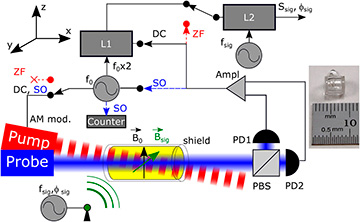![]()
Dave Howe of the U.S. National Institutes of Standards and Technology (NIST) leads an effort to use optically pumped magnetometers (OPMs) as receivers for low-frequency “magnetic radio,” to enable better wireless communications underground, underwater and in other environments that are challenging for conventional RF communications. [Image: Burrus/NIST]
Researchers at the U.S. National Institute of Standards (NIST) are working on ways to overcome a vexing problem of a wireless world: how to get usable signals in crowded built environments, underground and even underwater (Rev. Sci. Instr., doi: 10.1063/1.5003821).
At the heart of the team’s approach is an optically pumped magnetometer (OPM)—a highly sensitive, room-temperature quantum detector that can do double duty as a kind of magnetic-radio receiver. In the NIST setup, the OPM is used to pull in modulated signals encoded in very low frequency (VLF) magnetic fields, which are less prone to attenuation by the surrounding environment than a typical cell or GPS signal. And the team has coupled that sensitive detection technology with a modulation scheme that can pack more information into the otherwise limited bandwidth of VLF fields.
The skin-depth conundrum
Anyone who’s struggled to get a decent cell signal in a building basement knows the penetration limits of the high-frequency RF bands used by mobile phones. But the problem goes much further than simple inconvenience. For example, high-frequency-signal attenuation prevents military submarines and underground surveying operations from taking advantage of GPS location, and can cause GPS to cut out in the dense, skyscraper-lined canyons of urban downtowns. And it can block wireless communication among first responders picking their way through debris or rubble-cluttered disaster scenes.
Technically, those limitations relate to a quantity known as the skin depth—the depth in a material at which an AC electromagnetic field becomes attenuated to 1/e of its original strength. The skin depth is inversely proportional to the square root of the signal frequency (as well as the conductivity and relative permeability of the material the electromagnetic field is trying to penetrate). That means, for a given material, that the penetration depth for a signal in the gigahertz (GHz) band typical of modern wireless communications can be three orders of magnitude smaller than for a VLF channel in the kilohertz (kHz) range.
An obvious way to address the skin-depth issue is to communicate at very low frequencies. But those frequencies have their own problems. The biggest is extremely limited bandwidth, which rules out data-intensive applications like position detection or video. Another problem is the large antennas required to pull in the faint VLF signals using conventional receiving equipment. As a result, while the VLF band is now used for communications with submarines underwater, the data exchange amounts to little more than text messages—and, to receive them, the sub must spool out a long antenna and rise to periscope depth.
A quantum solution
The NIST team, led by researcher Dave Howe, has proposed a solution to VLF’s sensitivity problems: Encode the modulated signal on low-frequency magnetic fields—and then reconfigure the new generation of ultrasensitive magnetometers that’s emerging from quantum technology as magnetic-radio receivers. This would push the receiver’s ability to pick up VLF communications far beyond that of conventional RF receivers. And, the team suggests, picking the right modulation scheme for encoding the signal could hammer down ambient noise, allowing the best possible use of the available bandwidth in these low-frequency chanels.
The specific quantum sensor used by Howe’s team is an optically pumped magnetometer (OPM). These devices, typically employed to measure faint natural magnetic fields, are a bit more robust than alternatives such as superconducting quantum interference devices (SQUID), as OPMs can work at room temperature and have low size, power and cost requirements.
The optically pumped magnetometer (OPM) setup in the work by Howe’s NIST group. PD, photodiode; PBS, polarizing beamsplitter; L, lock-in amplifier. DC, ZF and SO refer to the magnetometer’s three operating modes: direct current, zero field, and self-oscillating. Photo at right shows the size of the rubidium atom vapor cell. [Image: Reprinted from V. Gerginov et al., Rev. Sci. Instr. 88, 125005 (2017), with the permission of AIP Publishing] [Enlarge image]
The instrument used by the NIST scientists works by firing pump and probe lasers into a vapor cell containing isotopically pure 87Rb atoms. Changes in the quantum spin of the atom ensemble due to an external, signal-carrying modulated DC magnetic field result in changes in the probe light’s polarization as it passes through the ensemble. Those changes, in turn, are read out at a balanced polarimeter at the end of the chain, and converted into AC signals to decode the magnetic-radio signal.
Meanwhile, on the transmission side, the team found that it could significantly reduce the impact of environmental noise—and, thus, boost the low-frequency signal’s carrying capacity—by adopting a digital binary phase-shift keying (BPSK) modulation scheme for the low-frequency magnetic-field signal. In particular, the BPSK modulation designed by the team had the effect of suppressing noise sources such as Earth’s natural magnetic background and the 50/60-Hz hum (plus harmonics) from the electrical power grid.
Picotesla sensitivity
In a proof of principle, the NIST researchers created a simple, single-channel digitally encoded DC magnetic signal, and found that the OPM setup could detect the faint, sub-kHz-frequency signal at picotesla field strengths, far below the ambient magnetic background noise, across a distance spanning tens of meters in the magnetically noisy indoor NIST setting. The team believes that range could be extended further, to the hundreds of meters, in less noisy environments, and through continued improvements both in sensor technology and signal modulation.
On that head, Howe’s group is working on a new custom quantum magnetometer that can provide still greater sensitivity, and on other techniques to reduce noise and expand bandwidth. In a press release, Howe likened the combining of quantum sensor technology and low-frequency magnetic radio to “inventing an entirely new field.”

